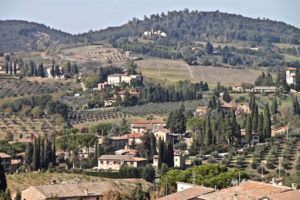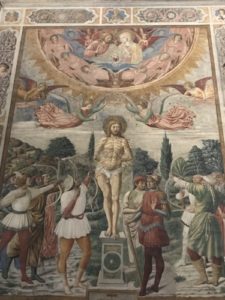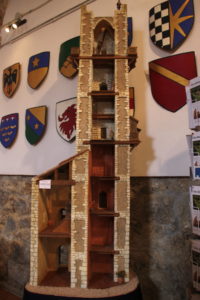San Gimignano is best known on the tourist circuit for its medieval tower houses. As a result, the town is sometimes called the “Manhattan of the Middle Ages.”
However, in, say, the 13th century, the town wouldn’t have been so exceptional — the wealthy, or the merely well-to-do, were building towers in many Italian cities, generally as defensive strongholds or to show off. Or both.
At the height of the building frenzy, San Gimignano’s leaders enacted a law forbidding construction of private towers taller than 170 feet.
Most towers did not survive, but a remarkable 14 (or 16 depending how you count — there are two sets of twin towers that are generally counted as one tower each) have survived in San Gimignano, an Italian town of not even 8,000 people.
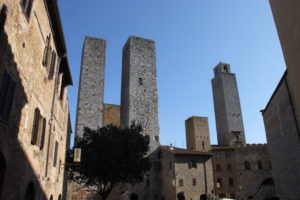
Several San Gimignano tower houses, including twin towers at left that were built by one home owner.
This fact brings on the tourists by the busload and has some cranky sorts decrying the place as a tourist trap.
The complainers need to get over it (my view).
Whether you have the town to yourself or are joined by hundreds, the towers are impressive. No tourist is tall enough to block your view, and nothing says you have to buy tacky souvenirs (which weren’t a hazard during my October 2018 visit anyway).
The towers are numerous enough, and the town small enough, for one or a few to be visible from almost any point in the historic town center.
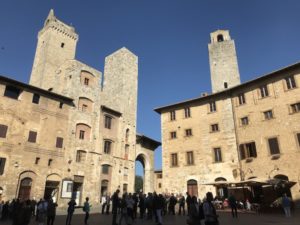
Tower houses seen in Piazza Cisterna, the heart of the medieval San Gimignano. The piazza was named for the well at its center (not visible in this photo).
Besides, even without the towers, San Gimignano is a Tuscan hill town with other charms — 13th century walls, medieval town hall and churches, and restaurants with great views of the countryside that spreads out below its perched setting.
San Gimignano’s tallest tower, the 177-foot Torre Grossa, attached to the city hall, is available for climbing, but my three fellow travelers and I lacked the time and inclination for that.
I learned later that another tower is outfitted as a rental home for tourists, and it is available for viewing when not rented. It gives new meaning to the world multiplex — 10 stories plus rooftop terrace!!
So, we didn’t see that, but we did, on a single-day visit, find other surprises.
Tops on that list was the interior of the 12th century Collegiate Church, with walls covered — and I do mean covered — by an amazing collection of frescoes. The church is quite dark inside, no doubt a key reason these vividly colored paintings have survived. (Luck is a factor, too, given that the frescoes survived World War II bombing of the town.)
In my trip diary, I recorded this:
<<The main church, the Collegiate Church, is a plain-looking building on the outside — but, the inside! Oh, my.
<<I was surprised by the series of 14th century frescoes, telling stories from the Old and New Testaments across the length of both sides of the church. The four of us spent some time, after adjusting to the dark interior, trying to figure out the content.
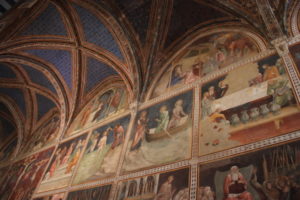
Above, New Testament scenes lining one side of the Collegiate Church in San Gimignano. For a closer look, below, a fresco illustrating the raising of Lazarus.
<<Art for the church’s two long sides was created by different artists, with the Old Testament side offering a bloodier take on things and a simpler style.
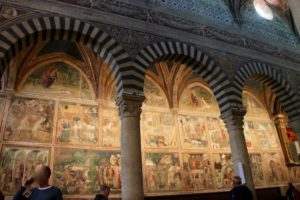
Above, Old Testament scenes lining one side of the Collegiate Church in San Gimignano. Below, closer views of vividly illustrated Old Testament stories.
<<Also, at one end, there is a large fresco of St. Sebastian, which was commissioned by city folk after they had prayed to him for relief from the plague, so says my Fodor’s guidebook. I don’t know that I would have been grateful to him, however, given that — according to Rick Steves’ “Hill Towns of Central Italy” — the Black Death sent the town’s population plummeting from 13,000 to 4,000.>>
I’ll mention another discovery, this one made with a prod from our guidebooks. My friends and I sought out “San Gimignano 1300,” a clay reproduction of what the town looked like when its full complement of 72 tower houses was in place in the Middle Ages.
We were easily entertained as we tried to recognize in the reproduction the places we had visited and the towers that survive.
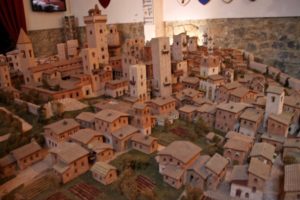
“San Gimignano 1300,” a clay reproduction of the town as it would have appeared when 72 tower houses still stood.
It cost us nothing to see “San Gimignano 1300,” but we followed the viewing with a productive visit to the exhibition’s shop, buying mementos to support this project — or so we told ourselves.
I want to highlight some tower houses that tourists can see elsewhere in Italy, but this posting is getting too long, so I offer another: https://besttripchoices.com/my-travel-corner/italy-beyond-the-towers-of-san-gimignano/
Meanwhile, for more about Tuscany, we offer at BestTripChoices.com the following, under the headline, Medieval walls, Chianti wine: https://besttripchoices.com/international-touring-areas/tuscanyhill-towns-italy/
This blog and its photos are by Nadine Godwin, BestTripChoices.com editorial director and contributor to the trade newspaper, Travel Weekly. She also is the author of “Travia: The Ultimate Book of Travel Trivia.”


